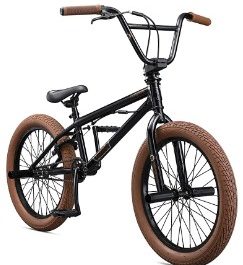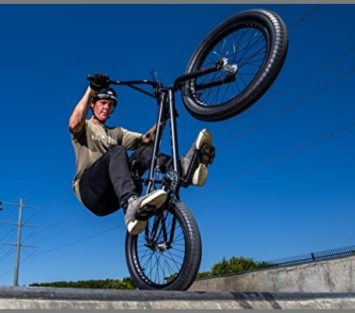Controversy and heated debates followed revelations that UCI BMX champion Twan van Gendt would use a 2-speed bike in the Tokyo 2020 Olympics BMX racing. Yes, you read right – a 2-speed BMX bike. “Do BMX bikes have gears?” you might wonder.
Generally, BMX bikes come with single-speed gears – meaning they only have one gear. The difference is in the gear ratios. For older generation BMX bikes and a few newer ones, the gear ratio is 44/16. However, modern BMX bikes run gear ratios of 30/9, 28/9, 25/9, 24/9, or even 22/8.
Do BMX Bikes Have Gears – The Details
Changes and developments are commonplace in the cycling world – BMX biking included. The fundamentals, however, remain the same.
Higher gear ratios like the 44/16 allow you to pedal quicker at an easy cadence. Cadence, measured in RPM (revolutions per minute), is the number of revolutions your pedal makes in one minute.
A rider gets more effortless acceleration with higher gear ratios but a reduced top speed. Contrariwise, lower gear ratios allow a rider to cycle slowly at an easy cadence.
However, with all the changes in the biking world, you might ask why BMX bikes retained single-speed gears?
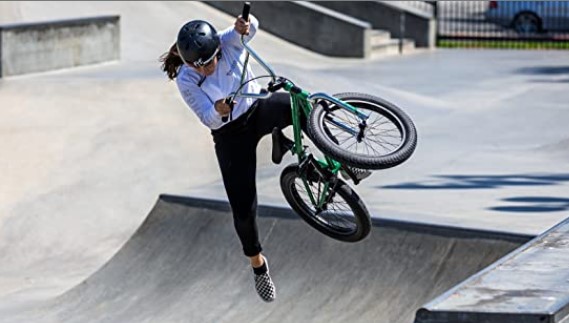
Why BMX Bikes Have Single-speed Gears
BMX bikes come with single gears mainly because of these reasons:
1. Mechanical Simplicity
Oscar Wilde stated, “Life is simple, and the simple thing is the right thing.” That statement also applies to BMX biking. As an extreme sport that consists of complex gravity-defying and daredevil stunts, shifting gears is an extra task that a rider doesn’t need.
You do not need to agonize about which gear to shift to with single-speed gears. You only have to give power to the pedal, and you’re on your way to the next trick. Also, the lack of gear-shifting levers and cables makes it easier to perform stunts and tricks.
Interestingly, some riders with multispeed gears rarely switch gears. They relentlessly worry that something might go wrong. A single-speed system simplifies things and eliminates that worry for a rider.
2. Easier Maintenance
There are fewer moving parts in a single-speed gear system. A BMX rider’s only worries are the tire pressure, chain tension, and braking system. For multispeed bikes, in addition to these worries, thought has to be given to derailleur and shifting lever systems also.
3. Reduced Weight
BMX bikes have a bare-bone structure to reduce the weight they carry. Specific BMX bike niches such as Park riding require as little weight as possible. Having single-speed gear plays a significant role in weight reduction.
4. Durability
For multispeed gear systems, derailleur and lever shifting mechanisms malfunction cause most of the problems. Single-speed systems in BMX are more durable since they do not have these systems installed.
5. Less Expensive
A bike’s upfront cost largely depends on hubs, levers, cables, derailleur systems, cranksets, etcetera. A majority of these components are not present in a single-speed gear system. Therefore, the cost, not the value, is generally lower.
Also, since some of the components mentioned are unavailable in single-speed gear systems, there is no cost for their repairs. They simply aren’t there.
Now that you know that BMX bikes have single-speed gears and why that’s the case, wouldn’t it be nice to know which gear ratio you’re currently running? Read on as we disclose a tip to help you identify your gear ratio and which ratio works for each BMX niche.
How Do I Know My BMX Gearing Ratio?
Count the number of teeth in the sprocket and divide by the number in the rear cog to know your gear ratio. Multiply the number you get by the wheel size. For older BMX bikes, the front sprocket teeth numbered 44, and the rear cog teeth numbered 16.
Therefore, for a 20-inch size wheel, the gear ratio is 44÷16 x 20 to give 55. Modern BMX bikes achieve a closer or similar ratio using smaller sprockets.
To get the rollout – which is the distance traveled after a single pedal revolution – multiply the gear inch ratio by pi (3.14). Therefore, the 20-inch bike moves 172.7 inches on a single pedal revolution (3.14 x 55).
What Gear Ratio Works for Each BMX Discipline?
Remember that the best gear ratio comes with your bike – your bike’s stock components. Currently, most BMX bikes have a 25t/9t gearing ratio like this Odyssey La Guardia Grips (Check on Amazon).
If you intend to change your gear ratio, you should know your intent for going for a specific gearing ratio. Why? Going a tooth up or down will affect the feel and performance of your bike.
It’s also important to note that the more teeth on your front sprocket, the higher the top speed. Fewer teeth on the front sprocket translate to faster acceleration.
Therefore, arming yourself with the specific reason you want to change your gears will let you know what works and adjust accordingly.
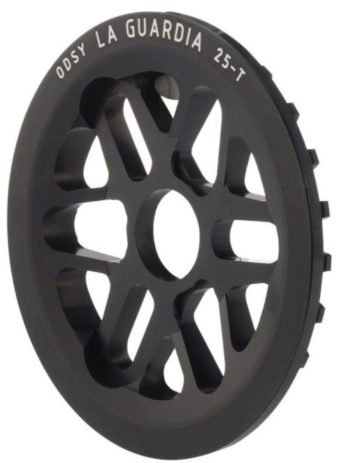
Best BMX Gear Ratio for BMX Racing
In BMX racing, the first 30 feet are crucial. That’s where the race is generally won or lost. So, a rider needs speed to be in the lead in the first turn. After that, winning the race is almost a guarantee.
Race BMX bikes have a higher gearing ratio to give you that extra burst of speed. Riders achieve higher speeds by using bigger front sprockets or smaller rear cogs.
You’ll see BMX racers with 46t/16t or the classic 44t/16t sprockets like Haro Team Vintage (View on Amazon)
BMX Gear Ratio for Street Riding
The 25/9 ratio works best for street riding. This ratio comes in handy for short run-ups that need a bit of cranking. You will also perform ledge-riding and other street-riding aspects perfectly well with this gear ratio.
BMX Gear Ratio for Park Riding
The 25/9 ratio also works well for technical Park riding tricks and stunts. The sprocket will not hit the coping edges while riding due to its smaller size. However, if your riding includes jumps that require cranking in-between, go for the bigger 28 tooth sprocket. Most BMXers have made a switch to the 28 teeth sprocket like this Black Ops (View on Amazon) for versatility and a better feel
BMX Gear Ratio for Dirt Riding
Most Trail or Dirt BMX riders go for bigger front sprocket sizes of 30, 31, or 32 teeth. These sprockets are bigger because fewer obstacles can damage them in dirt riding. With these bigger sprockets, the pedal power transmission is efficient. The bike also feels firm and offers more stability.
BMX Gear Ratio for Flatland Riding
Flatland riders generally have the less common gearing ratios of 22, 23, or 24 teeth for the front sprocket. With this sprocket, the bike remains compact and can perform spins and other tricks. And boy, aren’t there tricks in Flatland. It’s perhaps why Flatland gets its reference as “artistic cycling with a blend of breakdancing”!
Maintenance of BMX Drivechain and Gear Components
Make it a habit to visually check your bike before going out for a ride.
Here are a few things to check on:
Check for wear patterns on the chain-link and rust on the chain. Use lube such as Purple Extreme or Muc-Off Dry Lube for rusty or corroded chains.
Be on the lookout for leaning or worn-out sprocket teeth. If you find slanting teeth, take out the sprocket and place it on a chunky piece of wood or cloth.
Take another piece of wood and carefully hit using a hammer to straighten the leaning teeth. If you notice the leaning teeth while on the road and don’t have your tools with you, make the bicycle lay on its sides and use a stone or wood to straighten the tooth.
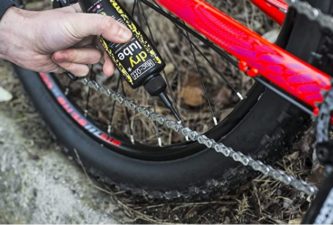
People Also Ask
How Many Gears Do BMX Bikes Have?
BMX bikes are single-speed bikes because they only have a single cog on the rear wheel. To calculate how many speeds a particular bike has, count how many front sprocket gears there are and multiply by the number of rear cogs.
How Do Gears Work On A BMX Bike?
BMX bikes with 2-speed gear speeds work using several cogs – mainly two. One cog runs the traditional BMX racing gearing. The second one has a reduced cog dimension to make the pedal harder. A lever placed on the handlebars helps switch from one speed to another.
Are BMX Bikes Fixed Gear?
BMX bikes are not fixed-gear bikes. Fixed-gear bikes, also known as Fixies, have the rear hub and wheel fused. Therefore, the pedal spins when the rear wheel rotates. You cannot stop pedaling on a fixed-gear bike and therefore cannot coast.
BMX bikes are not fixed-gear bikes because riders can coast.
Can You Put Gears On A BMX Bike?
It is possible to put gears on a BMX bike. You will, however, have to make a few adjustments to pull off the change. First, BMX bike frames have no derailleur hangers. You will need to use adaptors.
Alternatively, you could use an ultra-short cage derailleur model such as Shimano Zee Shadow Plus mounted with the axle. The downside is that the derailleur will be closer to the ground and prone to damage.
One can also use internally geared hubs. Lubricants and gears in an internally geared hub are sealed within a shell and therefore not exposed to the elements. They’re generally long-lasting and maintenance-free.
Unfortunately, internally geared hubs don’t do well under high stress. If you decide to go the internally-geared hubs route, ensure that your riding style and BMX niche are more on the “calm” side.
Otherwise, the hub’s complexity makes roadside repairs complicated in case of a breakdown.
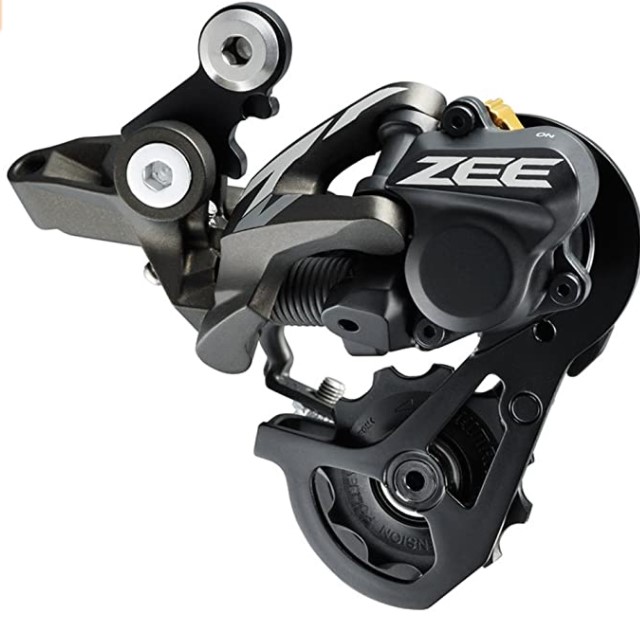
In Conclusion – Do BMX Bikes Have Gears?
Traditionally, BMX bikes come with single-speed gears with different gear ratios. This article has touched on several of those gear ratios. Several riders, however, have made attempts to popularize multispeed BMX bikes. BMX purists frown upon this. Whether the trend catches on or not remains a matter of time.
Relevant:
